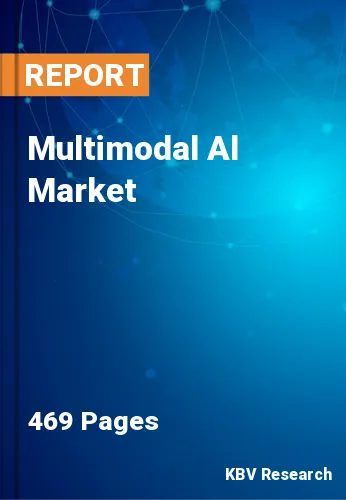The Global Multimodal Al Market size is expected to reach $8.4 billion by 2030, rising at a market growth of 32.3% CAGR during the forecast period.
Multimodal AI assists content creators in generating and editing media content by analyzing various modalities, including text, images, and audio. Therefore, the media & entertainment segment acquired $84.2 million in 2022. It assists content creators in generating and editing media content by analyzing various modalities, including text, images, and audio. It automatically analyzes audio, video, and image content to generate descriptive tags and metadata. This facilitates content organization, search, and recommendation systems. It interprets spoken language and voice inputs, enabling applications like voice-controlled interfaces, voice search, and voice-activated assistants. It improves the viewing experience, enables instant replay, and enhances sports analytics.
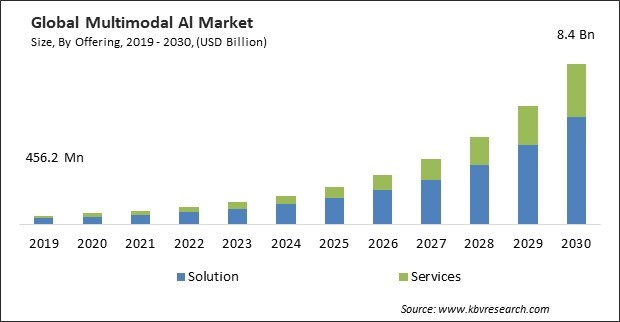
The major strategies followed by the market participants are Product Launches as the key developmental strategy to keep pace with the changing demands of end users. For instance, In, December, 2023, Amazon Web Services, Inc. a company of Amazon, Inc. has launched Amazon Q. With 17 years of AWS experience under its belt, Amazon Q is well-equipped to help consumers navigate the AWS administration panel and other AWS features. Additionally, In, November, 2023, Microsoft corporation has unveiled new AI-powered copilots for AI assistant to transform your way of work. Copilot is going to provide assistance in the context and intelligence of the web, with your privacy and security at priority.
Based on the Analysis presented in the KBV Cardinal matrix; Microsoft Corporation and Google LLC are the forerunners in the Market. In, November, 2023, Microsoft Corporation has expanded its range of Azure AI products by introducing new features in both generative and traditional AI capabilities. Developers can leverage Azure AI Studio, equipped with configurable tooling and models, to design innovative generative AI applications, including those incorporating Microsoft's Copilot generative AI assistant. Companies such as Meta Platforms, Inc., IBM Corporation are some of the key innovators in Market.
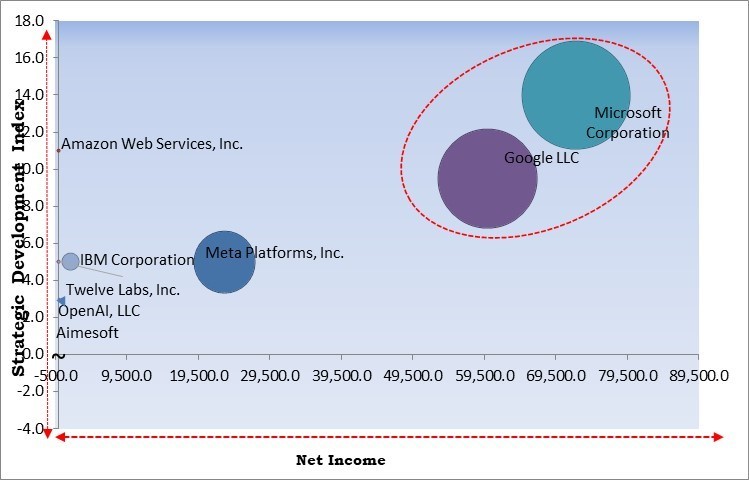
Generative AI is like the creative powerhouse of the AI world, capable of producing new content such as text, images, or even entire videos. It can create content that combines multiple data formats. For instance, it can generate detailed written descriptions for images, create realistic images from textual descriptions, or even produce videos with a nuanced understanding of the content. This blending of data formats is where Generative AI and multimodal AI synergize. As Generative AI advances, it not only enhances the creative aspects of multimodal AI but also paves the way for more sophisticated, integrated systems. Moreover, it can automate the creation of multimedia presentations, making them more impactful and informative. These aspects will boost market growth in the coming years.
Different industries have distinct workflows, regulations, and operational requirements. Customized solutions are designed to accommodate these specific needs, ensuring optimal functionality. Industries often operate under specific regulatory frameworks. Customized solutions can be developed to ensure compliance with industry norms and regulations, minimizing the risk of non-compliance. Custom solutions can be tailored to integrate seamlessly into existing workflows, automate processes, and enhance efficiency. This leads to increased productivity and reduces operational costs. The industries with direct customer interactions benefit from customized solutions that align with customer preferences, improving customer satisfaction. Thus, the rising demand for customized and industry-specific solutions expands the market growth.
Multimodal AI models, like their unimodal counterparts, are vulnerable to bias, which often originates from the data they are trained on. Training datasets, comprising text, images, videos, and more, may inadvertently reflect societal or cultural biases in the data sources. These biases can manifest in numerous ways, such as gender or racial bias in image recognition or linguistic and contextual bias in natural language processing tasks. When multimodal AI models are trained on such data, they inevitably inherit and perpetuate these biases, which can lead to inaccurate or unfair outcomes when making predictions or decisions. It also necessitates an ongoing commitment to ethical AI development and the responsible use of these technologies, ensuring that AI systems are technically proficient and aligned with ethical and societal values. Hence, the above aspects will hamper market growth in the coming years.
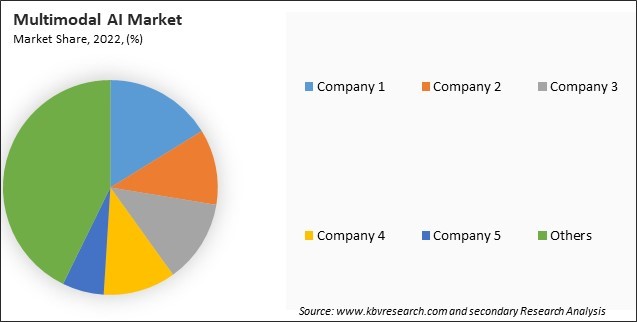
The leading players in the market are competing with diverse innovative offerings to remain competitive in the market. The above illustration shows the percentage of revenue shared by some of the leading companies in the market. The leading players of the market are adopting various strategies in order to cater demand coming from the different industries. The key developmental strategies in the market are Product Launches and Product Expansions.
On the basis of offering, the market is segmented into solution and services. In 2022, the solution segment dominated the market with the maximum revenue share. Solutions for implementing multimodal AI in smart city initiatives include traffic management, public safety applications, and environmental monitoring using data from various sensors and cameras. Solutions are designed to analyze medical imaging data, incorporating modalities such as MRI, CT scans, and X-rays. These solutions assist in medical diagnosis and treatment planning. Solutions specifically designed for processing and analyzing speech and audio data. This includes speech recognition, natural language processing for audio, and voice biometrics.
Under solutions type, the market is further divided into framework, platform, and software. In 2022, the platform segment dominated the market with the maximum revenue share. Such platforms provide a unified environment where developers, data scientists, and businesses can leverage various AI modalities (text, image, speech, etc.) to create sophisticated and interconnected AI systems. Platform solutions in the market aim to simplify the development process, promote collaboration, and enable businesses to harness the power of diverse data types for more advanced and context-aware AI applications.
On the basis of type, the market is classified into generative, translative, explanatory, and interactive. The translative multimodal AI segment recorded a remarkable revenue share in the market in 2022. This term could imply the integration of translation capabilities with multimodal AI, suggesting a system that not only translates text but also understands and processes information from multiple modalities. Translating videos, presentations, or documents that contain a combination of text, images, and audio.
By technology, the market is categorized into machine learning, natural language processing, computer vision, context awareness, and internet of things. In 2022, the natural language processing segment registered the highest revenue share in the market. Natural Language Processing (NLP) is a field of AI focusing on the interaction between computers and human language. It involves the development of algorithms and models that enable computers to understand, interpret, and generate human-like text. NLP encompasses many tasks and applications, from simple tasks like language translation to more complex ones like sentiment analysis and text summarization.
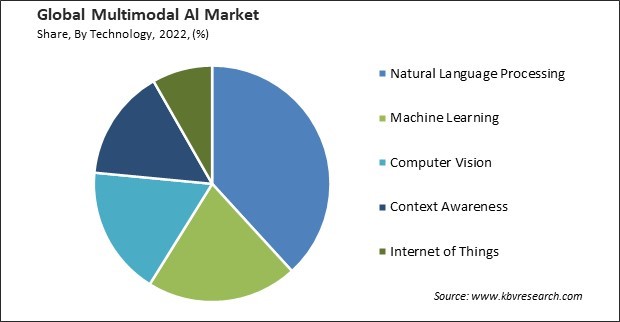
Based on data modality, the market is fragmented into text data, speech & voice data, image data, video data, and audio data. The video data segment recorded a remarkable revenue share in the market in 2022. Videos are composed of individual frames, each representing a still image. The rapid succession of frames creates the illusion of motion. Video data modality is integral to various applications, including video content analysis, surveillance, entertainment, education, and healthcare. As technology advances, video analysis capabilities in AI systems are expected to improve further, enabling a more sophisticated understanding of dynamic scenes and human activities.
Based on vertical, the market is divided into BFSI, retail & eCommerce, telecommunications, government & public sector, healthcare & life sciences, manufacturing, automotive, transportation & logistics, media & entertainment, and others. The retail & eCommerce segment acquired a substantial revenue share in the market in 2022. AI-powered virtual try-on solutions enable customers to visualize how products like clothing, accessories, or even furniture will look on them or in their homes using augmented reality (AR). It analyzes customer behavior, including browsing history, purchase patterns, and interactions with different media types. This information is then used to provide personalized product recommendations. Increases cross-selling and upselling opportunities, improves customer satisfaction, and enhances conversion rates.
| Report Attribute | Details |
|---|---|
| Market size value in 2022 | USD 923.2 Million |
| Market size forecast in 2030 | USD 8.4 Billion |
| Base Year | 2022 |
| Historical Period | 2019 to 2021 |
| Forecast Period | 2023 to 2030 |
| Revenue Growth Rate | CAGR of 32.3% from 2023 to 2030 |
| Number of Pages | 469 |
| Number of Tables | 804 |
| Report coverage | Market Trends, Revenue Estimation and Forecast, Segmentation Analysis, Regional and Country Breakdown, Competitive Landscape, Market Share Analysis, Porter’s 5 Forces Analysis, Company Profiling, Companies Strategic Developments, SWOT Analysis, Winning Imperatives |
| Segments covered | Offering, Type, Technology, Data Modality, Vertical, Region |
| Country scope |
|
| Companies Included | Google LLC (Alphabet, Inc.), Microsoft Corporation, OpenAI, L.L.C., Meta Platforms, Inc. (Meta), Amazon Web Services, Inc. (Amazon.com, Inc.), IBM Corporation, Twelve Labs Inc., Aimesoft Inc., Jina AI GmbH, and Uniphore Technologies Inc. |
| Growth Drivers |
|
| Restraints |
|
Region-wise, the market is analysed across North America, Europe, Asia Pacific, and LAMEA. In 2022, the North America region held the highest revenue share in the market. The market in North America stands as a global powerhouse, shaped by the innovation and technological ability of the US and Canada. The region's focus on innovation, particularly in Silicon Valley, fosters a conducive environment for multimodal AI advancements. North American companies are at the forefront of developing and implementing multimodal AI solutions, reflecting the region's commitment to driving technological advancements and pushing the boundaries of artificial intelligence for enhanced user engagement and problem-solving.
Free Valuable Insights: Global Multimodal Al Market size to reach USD 8.4 Billion by 2030
The market research report covers the analysis of key stake holders of the market. Key companies profiled in the report include Google LLC (Alphabet, Inc.), Microsoft Corporation, OpenAI, L.L.C., Meta Platforms, Inc. (Meta), Amazon Web Services, Inc. (Amazon.com, Inc.), IBM Corporation, Twelve Labs Inc., Aimesoft Inc., Jina AI GmbH, and Uniphore Technologies Inc.
By Offering
By Type
By Technology
By Data Modality
By Vertical
By Geography
This Market size is expected to reach $8.4 billion by 2030.
Generative AI techniques to accelerate multimodal ecosystem development are driving the Market in coming years, however, Susceptibility to bias in multimodal models restraints the growth of the Market.
Google LLC (Alphabet, Inc.), Microsoft Corporation, OpenAI, L.L.C., Meta Platforms, Inc. (Meta), Amazon Web Services, Inc. (Amazon.com, Inc.), IBM Corporation, Twelve Labs Inc., Aimesoft Inc., Jina AI GmbH, and Uniphore Technologies Inc.
The expected CAGR of this Market is 32.3% from 2023 to 2030.
The Generative segment is generating the highest revenue in the Market by Type in 2022; thereby, achieving a market value of $3.5 billion by 2030.
The North America region dominated the Market by Region in 2022, and would continue to be a dominant market till 2030; thereby, achieving a market value of $3 billion by 2030.
Our team of dedicated experts can provide you with attractive expansion opportunities for your business.
